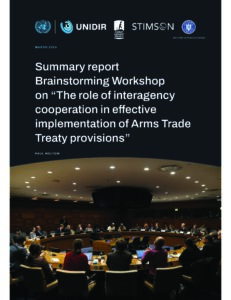Introduction
The Arms Trade Treaty (ATT) represents the first legally binding instrument to regulate the global trade in conventional arms. The treaty entered into force in December 2014 and aims to reduce human suffering and mitigate harm caused by irresponsible and illegal arms transfers. The treaty establishes common standards for international transfers of conventional weapons and aims to improve transparency and build confidence between States engaging in international arms transfers and establishes mandatory reporting mechanisms.
The ATT requires States Parties to submit two reports to the treaty Secretariat in order to increase responsibility, accountability, and transparency in the arms trade.
- First, States Parties are required to submit an initial report on treaty implementation that provides details on national laws and measures regulating arms transfers. States Parties are required to update this report should they make changes to their national arms transfer controls systems.
- Second, States Parties are obliged to submit annual reports on authorized or actual arms exports and imports that occurred during the previous calendar year. These reports are due by 31 May each year. In practice, however, the ATT Secretariat extends a seven-day grace period for the submission of annual reports, creating a de facto annual reporting deadline of 7 June each year.
ATT initial reports are an essential tool available to States, the ATT Secretariat, and non-government experts and stakeholders for understanding, monitoring, and evaluating treaty implementation. ATT initial reports provide a number of benefits:
- Indicating how States Parties interpret and implement the treaty’s obligations;
- Providing an opportunity for reporting States Parties to assess their national control systems, identify gaps, and make adjustments as needed;
- Helping to identify good practices and offer insights into common definitions and patterns in control measures;
- Shining a light on assistance needs to advance treaty implementation and States Parties that might be in a position to provide such assistance; and
- Capturing treaty compliance and helping to determine the extent to which the treaty is meeting its potential in strengthening arms transfer regulations, improving transparency, and ultimately mitigating harm.
Unfortunately, ATT initial reporting has been challenged by stagnant compliance rates, increasing challenges to transparency, and – at times – limited information on how States Parties are implementing the treaty’s provisions. These challenges risk limiting the utility of ATT initial reports and undermining the establishment of a shared understanding of how the ATT affects national regulations to improve arms transfer controls around the world. The challenges to reporting efficacy and impact deserve greater scrutiny and attention from States Parties and other concerned stakeholders.
This report examines whether ATT initial reports – including any updates States Parties may have submitted to prior reports – contribute to a comprehensive understanding of how States Parties are implementing the ATT and assesses the extent to which they provide greater insight into national transfer control systems than would otherwise exist. In doing so, this report examines trends in initial ATT reporting from December 2015 – when the first cohort of States Parties was first required to submit their initial reports – through December 2021 – in which all current States Parties should have submitted their initial reports to the treaty Secretariat. The report comprises five sections. Section one reviews the status of reporting as of 31 December 2021 and examines patterns in how States Parties have submitted their initial reports. Section two reviews information in the 64 publicly available initial reports on States Parties’ national arms transfer control systems. Section three compares reporting to the ATT and the UN Programme of Action on Small Arms and Light Weapons. Section four examines challenges to ATT initial reporting and assesses gaps and uncertainties in treaty implementation that appear to result from such challenges. The fifth and final section offers concluding thoughts on ATT initial reporting, insights on available resources to advance treaty implementation, and recommendations for improving States Parties’ efforts.
For detailed insights on ATT annual reporting over the last six years, see Taking Stock of ATT Annual Reports.




